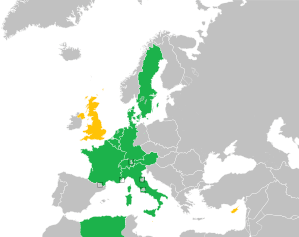Eurovision Song Contest 1958
| Eurovision Song Contest 1958 | |
|---|---|
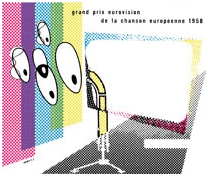 | |
| Dates | |
| Final | 12 March 1958 |
| Host | |
| Venue |
AVRO Studios Hilversum, Netherlands |
| Presenter(s) | Hannie Lips |
| Conductor | Dolf van der Linden |
| Host broadcaster | Nederlandse Televisie Stichting (NTS) |
| Interval act | Metropole Orkest |
| Participants | |
| Number of entries | 10 |
| Debuting countries | |
| Returning countries | None |
| Withdrawing countries | |
|
Participation map
| |
| Vote | |
| Voting system | Ten-member juries distributed 10 points among their favourite songs. |
| Nul points | None |
| Winning song |
"Dors, mon amour" |
The Eurovision Song Contest 1958 was the third Eurovision Song Contest. The contest took place in Hilversum, Netherlands, following the country's win at the 1957 Contest, forming the convention that the winning country of the previous Eurovision Song Contest hosts the following year's contest. The event was held on Wednesday 12 March 1958 at AVRO Studios. The winner was France with the song "Dors, mon amour", performed by André Claveau, written by Pierre Delanoë and composed by Hubert Giraud. At 46 years and 76 days of age, Claveau became the oldest victor of the contest until 1990[1].
Ten countries participated, with Sweden making its début and France winning the contest for the first time. The United Kingdom was the first choice to stage the contest; however, following a failure to get an agreement from various artistic unions, the BBC withdrew their bid in the summer of 1957 and the United Kingdom did not enter for the second and last time to date, having also missed the first contest two years earlier.[2] Along with 1956, it was the second contest (and last contest to date) that has not featured a single song in the English language. The 1958 contest continued with the policy implemented the year before where each country was limited to one song entry. This policy has been retained to date.[3]
Location
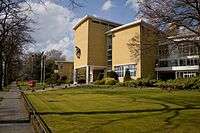
Hilversum, a municipality and a town in the province of North Holland, is known as the "Media Capital" of the Netherlands.[3] Hilversum had become the centre of broadcasting and radio in the Netherlands in the 1920s when Dutch radio company Nederlandse Seintoestellen Fabriek settled there, and today the media sector stands as one of the top employers in the municipality of Hilversum.[4]
After the establishment of the Dutch Radio Company in Hilversum in the 1920s, almost all other radio stations in the Netherlands followed suit with television following in the 1950s, thus making Hilversum at the end of the 1950s the best venue in the Netherlands to produce and broadcast such an international TV-transmitted event as the Eurovision Song Contest, while on the other hand TV was still a challenging advanced technology in general within Europe.
One such media network was the host of the event, Nederlandse Televisie Stichting. The venue of the contest was the studio of AVRO (Algemene Vereniging Radio Omroep or "General Association of Radio Broadcasting"), a building complex for the media's network among the media buildings within Hilversum, and which belonged to the Dutch public broadcasting association operating within the framework of the Nederlandse Publieke Omroep system.
Format
The contest was held in one of the Avro studio halls. The hall contained a very small stage to function as a slightly higher stand for the singers, with the program being shot from the stage floor up. Outside of frame were the microphones' and other technical devices' wires which went through the studio's lower floor at the foot of the stage. The decorative emphasis was on the stage background, the stage front and the left side from the stage from the spectator's view where the orchestra and where the performers and host's stairway entrance were located. The rear of the stage had interchangeable backgrounds for each song to add context to each song's lyrics. The centre-front of the stage, the left area from the stage with the orchestra and stairway entrance were decorated with tulips, of which the Netherlands are known for.[3]
The juries were not in the studio as in 1956. For the 1958 event, they remained in their own countries, listening to the event. Once the songs had all been sung, juries announced their results via telephone in reverse order of presentation, as in the previous year. The Italian entry was not picked up properly in some of the other countries, which meant that after all the other songs had been presented, Domenico Modugno had to perform his song again. It was the only year that the host country finished in last place until 60 years later in 2018, and the first time more than one country was placed last. The interval act was music by the Metropole Orkest, under the direction of maestro Dolf van der Linden. There were two interval acts, one in the middle of the competing songs performances and one after all the rest of the competing performances were shown.
Participating countries
Sweden, a country that would later be one of the most successful in the contest, debuted this year. The United Kingdom decided to withdraw from the contest after initially planning to submit an entry.[2]
After the contest, the Italian entry "Nel Blu Dipinto Di Blu" (subsequently known as "Volare") by Domenico Modugno went on to become a worldwide hit. During the 1st Grammy Awards, held on 4 May 1959 at Hollywood's Beverly Hilton Hotel, "Nel blu dipinto di blu" received two awards, for Record of the Year and Song of the Year.[5] The song is the only foreign-language recording to achieve this honour,[6] and it is the only song to have competed in the Eurovision Song Contest and received a Grammy Award.[7] The song also reached the No.1 spot in the US-American Billboard Charts, making it one of the most successful Eurovision songs in the history of the contest. The song was also voted the second best Eurovision entry of all time at the 50th anniversary show "Congratulations" in 2005.
Conductors
Each performance had a conductor who conducted the orchestra.[8]






.svg.png)



Returning artists
Four artists who had participated in previous editions of the contest returned in 1958: Fud Leclerc, who also represented Belgium in 1956; Margot Hielscher for Germany, who also participated in 1957; Corry Brokken for the Netherlands, who participated in 1956 and won in 1957; and Lys Assia, who won the first contest in 1956 and participated in 1957.
Results
| Draw | Country | Artist | Song | Language[9] | Place | Points |
|---|---|---|---|---|---|---|
| 01 | Domenico Modugno | "Nel blu dipinto di blu" | Italian | 3 | 13 | |
| 02 | Corry Brokken | "Heel de wereld" | Dutch | 9 | 1 | |
| 03 | André Claveau | "Dors, mon amour" | French | 1 | 27 | |
| 04 | Solange Berry | "Un grand amour" | French | 9 | 1 | |
| 05 | Alice Babs | "Lilla stjärna" | Swedish | 4 | 10 | |
| 06 | Raquel Rastenni | "Jeg rev et blad ud af min dagbog" | Danish | 8 | 3 | |
| 07 | Fud Leclerc | "Ma petite chatte" | French | 5 | 8 | |
| 08 | Margot Hielscher | "Für zwei Groschen Musik" | German | 7 | 5 | |
| 09 | Liane Augustin | "Die ganze Welt braucht Liebe" | German | 5 | 8 | |
| 10 | Lys Assia | "Giorgio" | German, Italian | 2 | 24 |
Scoreboard
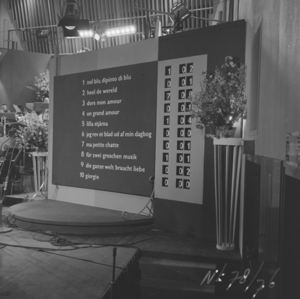
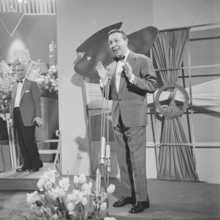
Each country had 10 jury members who each decided the best song and each awarded 1 point.
| Voting results | ||||||||||||
|---|---|---|---|---|---|---|---|---|---|---|---|---|
| Italy | 13 | 1 | 1 | 1 | 4 | 4 | 1 | 1 | ||||
| Netherlands | 1 | 1 | ||||||||||
| France | 27 | 6 | 1 | 1 | 9 | 1 | 1 | 7 | 1 | |||
| Luxembourg | 1 | 1 | ||||||||||
| Sweden | 10 | 2 | 3 | 1 | 1 | 3 | ||||||
| Denmark | 3 | 1 | 1 | 1 | ||||||||
| Belgium | 8 | 1 | 1 | 5 | 1 | |||||||
| Germany | 5 | 2 | 1 | 1 | 1 | |||||||
| Austria | 8 | 3 | 1 | 1 | 1 | 2 | ||||||
| Switzerland | 24 | 4 | 6 | 3 | 5 | 4 | 2 | |||||
International broadcasts and voting
The table below shows the order in which votes were cast during the 1958 contest along with the spokesperson who was responsible for announcing the votes for their respective country. Each national broadcaster also sent a commentator to the contest, in order to provide coverage of the contest in their own native language. Details of the commentators and the broadcasting station for which they represented are also included in the table below.[10]
| Voting order | Country | Spokespersons | Commentator(s) | Broadcaster(s) |
|---|---|---|---|---|
| 01 | Mäni Weber | Theodor Haller, Pierre Tchernia | TV DRS, TSR | |
| 02 | TBC | Wolf Mittler | ORF | |
| 03 | Claudia Doren | Deutsches Fernsehen | ||
| 04 | Paule Herreman | Arlette Vincent, Nic Bal | INR, NIR | |
| 05 | Svend Pedersen | Gunnar Hansen | Statsradiofonien TV | |
| 06 | Roland Eiworth | Jan Gabrielsson | Sveriges Radio-TV | |
| 07 | Pierre Bellemare | Pierre Tchernia | Télé-Luxembourg | |
| 08 | Armand Lanoux | RTF | ||
| 09 | Piet te Nuyl | Siebe van der Zee | NTS | |
| 10 | Fulvia Colombo | Bianca Maria Piccinino | Programma Nazionale | |
| - | - | Peter Haigh | BBC Television Service |
National jury members
.svg.png)
References
- ↑ O'Connor, John Kennedy. The Eurovision Song Contest - The Official Celebration. Carlton Books, 2015. ISBN 978-1-78097-638-9. Pages 32-33
- 1 2 "Shining a light on the United Kingdom: 60 Years at Eurovision". European Broadcasting Union. Retrieved 12 January 2017.
- 1 2 3 "Eurovision History – Hilversum 1958". European Broadcasting Union. Retrieved 5 March 2012.
- ↑ "From Hilvertshem to Hilversum" (in Dutch). Hilversum Mediastad. Archived from the original on 26 July 2012. Retrieved 23 October 2012.
- ↑ Dornbrook, Don (24 May 1959). "And Now the Grammy Awards". The Milwaukee Journal. Retrieved 1 May 2011.
- ↑ "GRAMMY Rewind: 1st Annual GRAMMY Awards". www.grammy.com. Retrieved 22 January 2012.
- ↑ "International Pull of Grammys Veries In Key Markets - Grammy Facts". Billboard. 6 March 1999. p. 101. Retrieved 24 January 2012.
- ↑ http://www.andtheconductoris.eu
- ↑ "Eurovision Song Contest 1958". The Diggiloo Thrush. Retrieved 4 March 2012.
- ↑ "Eurovision 1958 Cast and Crew Details". IMDb. Retrieved 5 March 2012.
- ↑ The BBC had scheduled to broadcast the Contest on the 12 March 1958, however due to live coverage of a sports event on the same day meant that the broadcast had to be delayed until March 16.
- ↑ http://www.andtheconductoris.eu/index.htm?http://www.eurovisionartists.nl/conductor/dir020.asp?ID=283
External links
| Wikimedia Commons has media related to Eurovision Song Contest 1958. |
